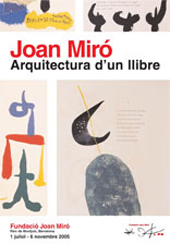- Dates
- —
A book must have all the dignity of a sculpture hewn from marble.
Joan Miró
An illustrated book is a space that a publisher provides for a poet and an illustrator to come together and create a dialogue between words and images.
In order to enter into the spirit of the poet and find the perfect match for his ideas, Miró would immerse himself in the language, the words and the rhythms, trying to master the technical difficulties they presented and carrying his art to its limits.
However, choosing the right paper, often hand-made or produced by traditional methods, selecting a specific typeface, deciding on the page make-up according to the patterns of the text, or choosing a print-making technique in keeping with the subject matter and being able to execute it with skill, are also essential in ensuring that the book will be the expression of something special and not just a mere object. Completing the intricate task of producing a book of this nature is only possible if there is close collaboration between poet, artist and publisher.
When the book finally sees the light of day, the reader will be able to appreciate its beauty but will not usually realise the immense amount of documentation and preparatory material behind the rigorous and often time-consuming teamwork. Miró’s correspondence with the poet, publisher and print-maker, which allows us to reconstruct the history of the book and obtain an insight into ambitious projects such as L’Antitête; the sketches he did on any old piece of paper, such as those he used first for Ubu aux Baléares and later for L’Enfance d’Ubu; the mock-ups for À toute épreuve and Càntic del sol , which show the various stages of creation up to the final state; or the printing plates that demonstrate his decision to use such varied techniques as woodblock prints for À toute épreuve or etchings and aquatints for Adonides, are all examples of the meticulous work that went into the books that Miró illustrated.
Having the opportunity to see this material gives the viewer an idea of this creative process that Miró shared with poets, publishers and print-makers, and in particular it enables us to capture the spirit of an illustrated book.


